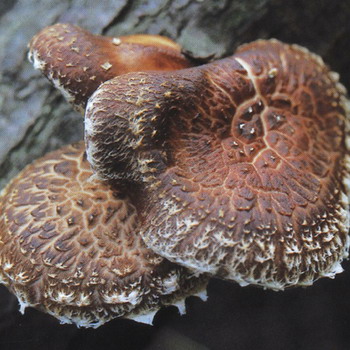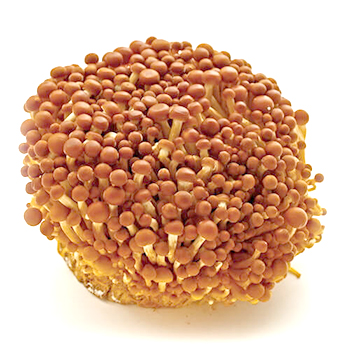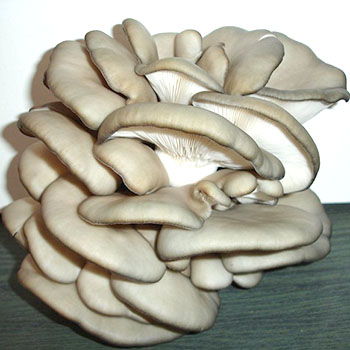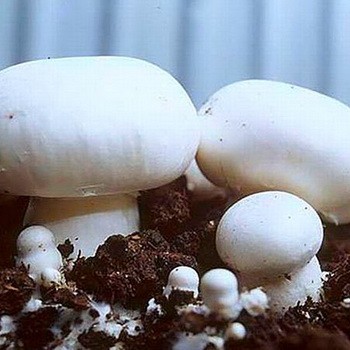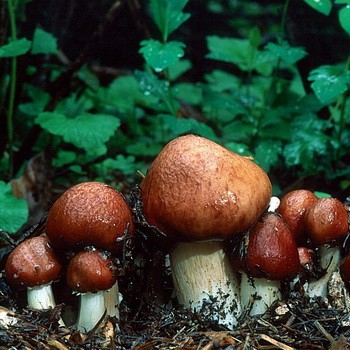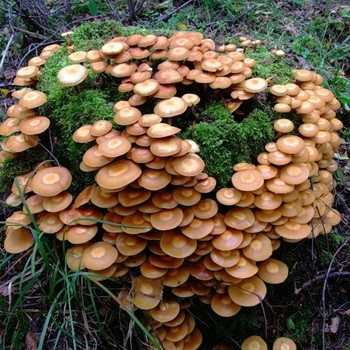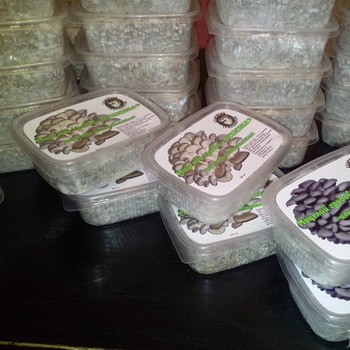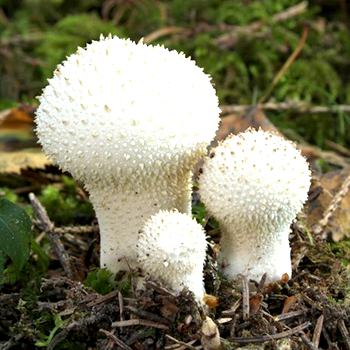Shiitake cultivation on stumps, in a greenhouse and autoclave
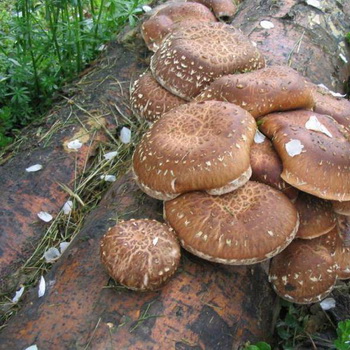
Content
- How to grow shiitake mushrooms in the country
- Production of substrate blocks for shiitake
- Incubation of fungal mycelium in shiitake cultivation
- Shiitake mushroom cultivation in a greenhouse (with video)
- How to grow shiitake using sterile technology
- Shiitake cultivation using an autoclave
- New technology for growing Shiitake with steam heat treatment
How to grow shiitake mushrooms in the country
Mushroom cultivation shiitake (Lentinula edodes) can be produced on logs or on trunks of any deciduous trees, but oak or beech is best suited. You can check the winter hardiness of several strains. So, the strain of Japanese forest mushrooms "40 80" successfully wintered in the open air at temperatures below minus 25 ° C. Harvesting and inoculation with mycelium of shiitake mushrooms of chumps is carried out in the same way as for oyster mushrooms. In the conditions of diurnal temperature fluctuations, shiitake bears fruit from May until late autumn better and more often than oyster mushroom.
The Chinese grow shiitake on long tree trunks. Stacked horizontally on the ground, the trunks look nice and give a good crop of mushrooms. Trunks of trees with a diameter of 7-15 cm are cut into pieces 100 cm long. An important condition for growing shiitake is the water content in the wood is about 38-42%. If the moisture content of the wood is less, then the trunks are watered several days before the introduction of the mycelium.
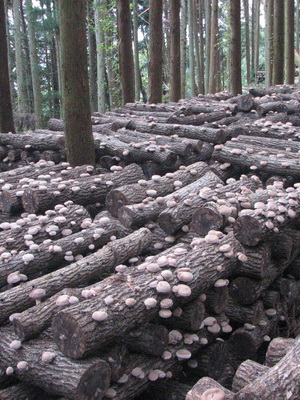
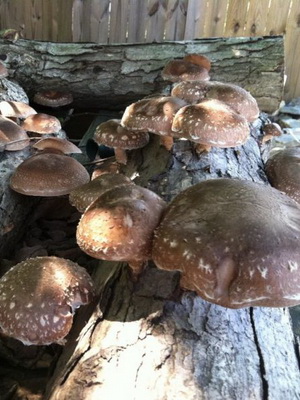
How to grow shiitake in the country, using stumps or logs? On the stems, drill holes in a checkerboard pattern at a distance of 10 cm from each other along the length of the stem and 7 cm between the rows of holes. The diameter of the holes is 12 mm, the depth is 40 mm. When growing a shiitake on logs, the mycelium is brought into the holes, the trunks are laid horizontally in high woodpiles to grow with mycelium and covered with a film on top. In a greenhouse or in a barn, incubate for at least a month at a temperature of + 20 ... + 26 ° C.
A stem is considered mature for fruiting if it does not “ring” upon impact, the mycelium has captured the outer edge of the sapwood and white zones of the mycelium are visible on the cross section of the stem. Before soaking, the trunks are tapped with a hammer or hit the butt on the ground. Breeding the shiitake at the cottage on logs, the trunks are soaked in water with a temperature of + 13 ... + 18 ° C for 12 hours. During the soaking, carbon dioxide - CO2 comes out of the trunks in the form of bubbles. When the bubbles cease to stand out, it means that the trunks can be removed from the water. Humidity of wood reaches 60%. With greater humidity, the intensity of fruiting of the mushrooms decreases.
To grow a shiitake on stumps, the trunks are dug horizontally half their diameter into the ground. In this case, it is easier to maintain the moisture content of the wood. If the plantation is not located in the greenhouse, but on the street, the plantation is covered with material that helps maintain the humidity necessary for fruiting.5-10 days after soaking at the places of the holes, the rudiments of shiitake mushrooms are formed. Good quality mushrooms are formed at low temperatures (+ 10 ... + 16 ° С) and moderate air humidity (60-75%).
Daily fluctuations in temperature and humidity contribute to the formation of better mushrooms with dense pulp and attractive appearance. The fruiting wave lasts 7-10 days.
After picking the mushrooms of the first wave, the trunks can withstand 2 months in drier and warmer conditions (+ 16 ... + 22 ° C). The humidity of the wood during this period is reduced to the level of 30-40%. The following fruiting waves are achieved by repeating the procedure of fruiting induction by soaking the trunks. If you have mastered the technology of how to grow shiitake mushrooms, you can use trunks in this way for 3-5 years. The total mass of mushrooms collected during this time is 15-20% of the mass of wood.
Here you can watch a video of growing shiitake mushrooms in your personal garden:
Production of substrate blocks for shiitake
The best material for future Shiitake substrate mycelium is shredded oak branches, but other deciduous trees can be used. Leaves from the branches are desirable to remove. Ground branches must be used immediately.
The amount of substrate per one substrate block is determined by the size of the plastic bag in which the soaked substrate is subjected to heat treatment, and then, after sowing, fungal mycelium develops there. It is the package that creates the necessary conditions for the development of mycelium. The package determines the future shape of the substrate block and its dimensions.
When stuffing a polypropylene sleeve with a width of 25.5 cm, a block with a diameter of 16 cm, a height of 28 cm with a volume of 5 l and a wet weight of 2.2 kg is obtained. When making a substrate from fresh branches of oak, willow or birch without leaves, add 200 ml of water per block. To increase productivity, 250 g of barley can be added to each block. In this case, the amount of water must be increased to 350 ml, and the mass of the block will be 2.8 kg.
For beginner mushroom growers, it is more convenient to use blocks weighing 1.3 kg with a substrate volume of 2.5 l in the block. So much fits in standard thin plastic packaging bags from "rusting" low-pressure polyethylene, which withstands heating up to +110 ° С.
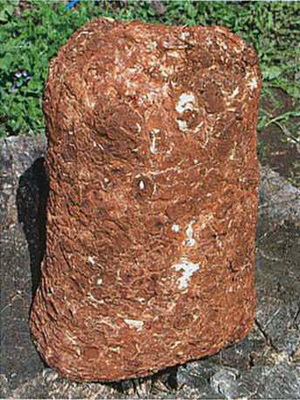
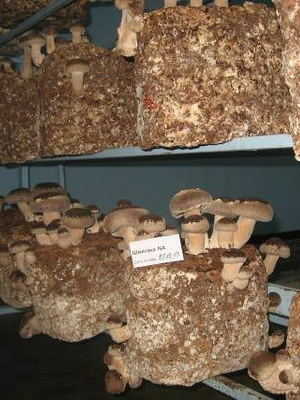
Before growing a shiitake, you need to make a substrate block. To do this, thoroughly mix the wood chips, grain and water in the required proportions in a basin and pack the mixture in bags. Make cotton plugs with a diameter of 2-3 cm from a synthetic winterizer that was not in use. To do this, tightly roll a strip of synthetic winterizer 30-40 cm long and 5-7 cm wide into a roll. Wrap the roll with thread. You can make such plugs from pure sterile cotton wool. Insert the corks in the neck of the bags with the substrate and tighten the bag around the cork with hemp or polypropylene twine. Leave the bags with the substrate overnight so that the moisture of the added water is absorbed into the grain and distributed throughout the volume of the substrate in the bag.
Sterilize the blocks with the substrate in a domestic autoclave at a temperature of +110 ° C for 3 hours. If there is no autoclave, fractionally pasteurize the blocks with the substrate. After the substrate has cooled, inoculate (inoculate), if possible under sterile conditions. To do this, open the bags and quickly pour 100 g of grain mycelium into the neck of each bag. Close the bag with a stopper, tightening the throat of the bag tightly with twine. There should be no slots or damage in the bag.
Inoculation of mycelium into the substrate should be carried out in a clean room without dust or on the street. Wipe a tablespoon and table surface with diluted Whiteness or another chlorine-based preparation. Install the substrate package on the table. With clean hands, mash the cereal mycelium intended for sowing. Untie the strapping of the bag with the substrate around the cork. Remove the cork and pour a tablespoon of grain mycelium on the substrate in the bag. Seal with my fingers or a spoon the mycelium on its surface.Insert the cork back and tie with twine. Form the substrate in a bag so that the substrate block can stand stably on a horizontal surface. To do this, turn the package over. Shake the substrate from the corners of the package, bend the corners along the bottom and glue them with a strip of adhesive tape.
Incubation of fungal mycelium in shiitake cultivation
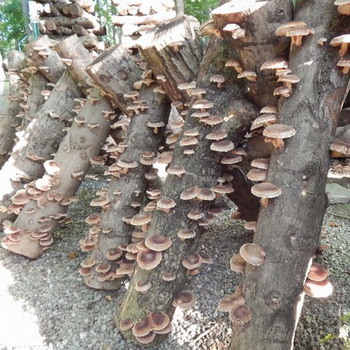 When the substrate blocks are held together by overgrown mycelium, they will be of the same and regular shape.
When the substrate blocks are held together by overgrown mycelium, they will be of the same and regular shape.
To develop substrate block by mycelium (for incubation of mycelium), leave the packet with the substrate in a warm place at a temperature of + 20 ... 26 ° C for 2 months or more. Through the film of the bag, you can monitor the progress of the mycelium from top to bottom as the substrate is captured. The block should turn white, or white with brown spots, or brown. It is believed that the brown block is ready to bear fruit, but this is not so. In the dark, the block mastered by shiitake mycelium remains white, and in the light becomes brown. This is due to the color of the exudate shiitake. In the dark, it is colorless, and brown in the light. White blocks begin to bear fruit simultaneously with brown ones.
On the block, characteristic growths of the same color as the rest of the surface of the block, called mushroom breeders popcorn, may appear. These are not the beginnings of fruiting bodies. Using these formations in nature, shiitake repels the bark of a tree. The rudiments of fruiting bodies (primordia) are dense dark tubercles, which then develop into the cap of the mushroom.
Shiitake unlike oyster mushrooms can form fruit bodies of the correct form with a high concentration of carbon dioxide - for example, when it is placed in a large plastic bag, closed not tightly or with openings. So that the fruiting bodies do not tear this package and rot inside, it must be removed on time.
The block can easily be overgrown with mycelium for growing shiitake in a shady area of the garden. Dates will change, but the overgrowing process will not stop and it will be better if you put the package with the block vertically, with a cotton plug up. But in the open space, you have to turn the blocks over so that the rain does not wet the cork, or cover them from above.
Shiitake mushroom cultivation in a greenhouse (with video)
Remove the polymer bags from ready-to-bear substrate blocks and wash the blocks under running cold water. Shiitake blocks are useful for bathing to initiate fruiting - in nature, mushrooms begin to grow rapidly with the onset of the rainy season. Install the substrate blocks in the place of their future fruit bearing on the ground or on the shelves.
In the case of installing blocks indoors, you need to create a suitable climate there. The optimum temperature is + 15 ... + 18 ° C. Relative humidity should be between 80 and 90%. In dry weather, you can use block watering or spraying water, but for rooms it is best to use an ultrasonic humidifier, the so-called manufacturer of fog or “cold steam”. Humidifiers can be turned on with a daily timer. For normal fruiting, shiitake needs lighting for 8-12 hours a day. Light does not have to hit all the mushrooms. At least one side of the substrate block must be lit.
In autumn, air humidity is optimal in any shady area of the garden. To bear shiitake blocks in the garden in summer, set them in the shade, in a cool place surrounded by plants. In the fresh air in dry weather, water the blocks and fruiting bodies.
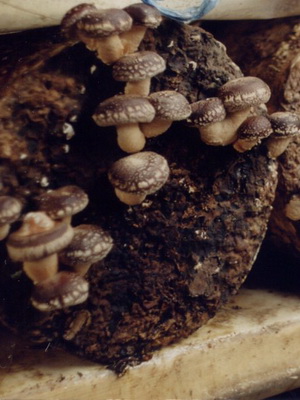
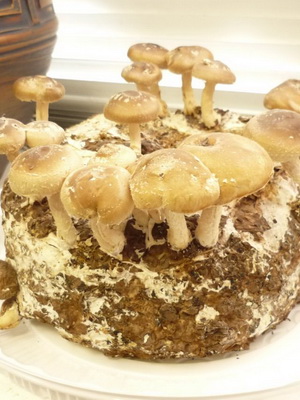
Shiitake blocks bear fruit well in an ordinary vegetable greenhouse, especially when surrounded by plants. A special greenhouse for shiitake can be built in the shade or protected from sunlight by a lightproof roof and a wall on the south side. In order for mushrooms to appear in the dry season in spring and summer, you can dig a shallow rectangular pit, cover it with turf and cover it with frames covered with any cheap non-woven material to cover the beds.
Intact blocks with a dense brown crust can be made to bear fruit even on the surface of the water.Typically, such blocks are quite dry and light in weight. To form the buds of mushrooms, the block must be placed in a puddle of rain, on the surface of the water in the pool or in a barrel. After about a week, the rudiments of fruiting bodies form on the wet side of the block. After this, the block must be turned over and after 7-10 days, high-quality fruiting bodies are formed on its surface.
After the first or the next wave of fruiting shiitake in the garden or greenhouse, evaluate the mass of blocks. If they have lost a lot of weight, they must be soaked. To do this, pierce the blocks with a sharp knife in several places through and through, but so as not to break the block.
Immerse them in water containers, pressing them with a heavy shield, and hold them under water for 12-16 hours.
Soaking will accelerate the onset of the next fruiting wave and restore the mass of the block.
Watch a video of growing shiitake in a garden greenhouse:
How to grow shiitake using sterile technology
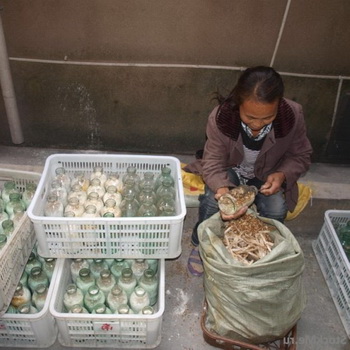 Rigid sterilization in autoclaves is carried out at a pressure of 1.1 atm for 2 hours. The moisture content of the substrate is 45-65%. Sterilization of the substrate leads not only to the death of the entire microflora, but also increases the availability of the lignocellulosic complex to the enzymatic decomposition of fungal mycelium. This increases the yield of mushrooms. After the death of microflora, the risk of infection by bacteria or mold greatly increases.
Rigid sterilization in autoclaves is carried out at a pressure of 1.1 atm for 2 hours. The moisture content of the substrate is 45-65%. Sterilization of the substrate leads not only to the death of the entire microflora, but also increases the availability of the lignocellulosic complex to the enzymatic decomposition of fungal mycelium. This increases the yield of mushrooms. After the death of microflora, the risk of infection by bacteria or mold greatly increases.
Pressure sterilization is carried out in special autoclaves. Convenient autoclaves are convenient. In this case, the loading of containers with the substrate is carried out from the dirty zone, and the unloading is carried out in a clean zone. Containers with a substrate are placed in the autoclave not closely, but at a small distance from each other so that air can circulate between them. This arrangement will ensure uniform steam distribution and substrate heating and significantly reduce sterilization time. The substrate to be sterilized must be moistened to the required level. Bags or jars with a substrate must be opened or closed leaking. After increasing the overpressure in the autoclave to 1 atm, it is necessary to purge with steam in order to release air from the autoclave - open the valve to release steam for 10 min with the heater running. It is very good to have a pressure gauge and a temperature sensor in the autoclave chamber. With an overpressure of 1 atm, the temperature in the chamber should reach +120 ° C. For complete sterilization of the contents of the autoclave, it is sufficient to withstand these parameters from 1 to 3 hours, depending on the mass of the substrate. It is permissible to heat to +110 ° C. With too long sterilization, the substrate becomes darker and its smell changes. It can become toxic to the mycelium of the fungus.
When the autoclave is turned off, the pressure and temperature in the chamber begin to slowly decrease. Ideally, a vacuum should form in the chamber. If the autoclave does not hold a vacuum, for example, with the valve open, then when it cools, it sucks in cold outdoor air. An autoclave having a pressure swing of +1 atm. up to -1 atm (vacuum, which is created during its cooling), provides good quality sterilization, because with such a pressure drop (2 atm), biological structures are more actively destroyed. Before opening the autoclave, equalize the pressure by letting the outside air into the chamber through a sterile cotton filter. For unloading, open the lid of the sterilizer autoclave. The substrate in the containers is still hot. If the autoclave is not a passage and its unloading is carried out in a dirty area, it is better to unload the substrate hot and place it for cooling in a sterile box under UV lamps.
Inoculation of the substrate is carried out in a sterile box. According to sterile technology on a wood substrate enriched with nitrogen additives, oyster mushroom yield reaches 100% of the dry weight of the substrate, or 50% of the wet weight of the substrate.
Shiitake cultivation using an autoclave
A shiitake farm produces 1 ton of mushrooms per month. The composition of the substrate is dry oak sawdust (90%) and rye grain (10%). The components are moistened with water on a clean floor up to 60%, add 1% gypsum and packaged in polypropylene bags.To increase breathability, replace 10% of sawdust with oak or alder wood chips. The bags with the substrate are placed in metal baskets and sterilized in autoclaves at elevated pressure for 2.5 hours. After cooling, the bags are taken out in a clean sterile zone and 100 g of shiitake mycelium are poured into each bag. Sowing rate 4%. The mass of the unit is 2.5 kg. Packages are closed with cotton plugs.
Sterile conditions are stored in the bag until the end of the incubation. The substrate blocks are incubated in chambers without fresh air for almost two months at an air temperature of + 22 ... + 24 ° C. The substrate during incubation first turns white, and then begins to acquire a brown color. The substrate is brought out for fruiting when more than half of the block turns brown. The blocks are freed from the film and placed in the fruiting chambers. In 8 fruiting chambers -30000 shiitake blocks. The forced-air ventilation unit provides humidification and heating of air. Lighting in the cameras is small, about 100 lux. For good shiitake fruiting, warm (not lower than +16 ° С) and moist (80-90%) air in the amount of 7500 m3 / h is supplied to the chambers. The fruiting cycle of shiitake with three waves is 120 days, and taking into account the incubation, the entire cultivation cycle takes 180 days, or 24 weeks.
Primordia (the primordia of mushrooms) are shiitake large. They appear from cracks in the outer crust of the substrate block. Primordia are formed over the entire surface of the block. The quality of mushrooms improves with a decrease in the night air temperature in the fruiting chamber.
Initiation of the first wave of fruiting is better with external short-term irrigation in blocks of water for several days. This watering is necessary in order to wash off the exudate formed during the incubation of blocks under the film. The initiation of the second and subsequent fruiting waves is carried out by soaking the blocks in water until their original mass is restored. To do this, the blocks are pierced through with skewers and poured into room temperature water at room temperature overnight. In the morning they are returned to the fruiting chamber. Hats are cut off during mushroom picking, leaving stumps that are removed from the block by twisting after a few days.
New technology for growing Shiitake with steam heat treatment
 One of the new technologies for growing Shiitake is a method with heat treatment by steam. The substrate workshop with an area of 100 m2 includes a small compartment for storing raw materials, a room with a substrate machine and a clean area where the finished substrate is inoculated. A 35 kW electric steam generator provides steam for heat treatment of the substrate.
One of the new technologies for growing Shiitake is a method with heat treatment by steam. The substrate workshop with an area of 100 m2 includes a small compartment for storing raw materials, a room with a substrate machine and a clean area where the finished substrate is inoculated. A 35 kW electric steam generator provides steam for heat treatment of the substrate.
Composition of the substrate: oak sawdust 70%, sunflower husk 20% and wheat bran 10%. The components of the substrate in dry form are loaded into a substrate machine (rotating barrel), the required amount of water is added and steamed for 4 hours at a temperature of + 90 ... + 100 ° C. All the time the barrel is steamed, it rotates to mix the substrate. The moisture content of the finished substrate should be approximately 60%.
The finished substrate is unloaded using a screw into a clean area. A laminar cabinet with a supply of purified filtered air is installed in the discharge zone. The substrate is poured into small plastic bags (packaging) and at the same time manually contribute mycelium in an amount of 2% by weight of the substrate. Inoculated bags are transferred through a lock window to a room where workers shake the bags to evenly distribute mycelium in the substrate. Next, bags on a trolley are transported to incubation chambers.
Three chambers were allocated for incubation with a total area of 500 m2 with a total load of 22,000 blocks of 1.8 kg each (a total of 40 tons of sub-118 stratum). To place the substrate using 7-tier shelving made of wood timber with PVC insulated metal mesh. The humidity in the incubation chambers is not regulated. The incubation process lasts 2.5 months (10 weeks).
Bags with the substrate are placed on racks at a short distance from each other. The air temperature is maintained so that the substrate does not cool below +26 ° C.
On the 20th day, white tubercles (“popcorn”) appear on the surface of the substrate. Then the blocks begin to brown. On the 70th day, the beginnings of fruiting bodies are formed, the film is removed from the blocks and transferred to the fruiting chamber.
For fruiting, three chambers are used with a total load of 10,000 blocks, or only 18 tons of substrate. The substrate is placed on 6-tier shelves of wood lumber. The cameras are equipped with climate control systems. To moisten the blocks, drip irrigation with water is used. Additionally, steam from an electric steam generator is used to humidify the air. The optimum fruiting temperature is shiitake + 14 ... + 16 ° C. The fruiting period on the first wave is 8-10 days.
In the period between the waves in the chamber, the temperature is raised by 4 degrees and the spraying of water is stopped to tighten the external damage to the block after collecting the mushrooms. For 3 weeks, the blocks "rest". After "rest" for several days spend abundant irrigation of blocks with water to restore their original mass. The air temperature is reduced, and the air humidity is brought to 90-95%. The yield on the first two waves of fruiting is 13-15%.
